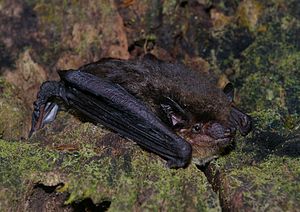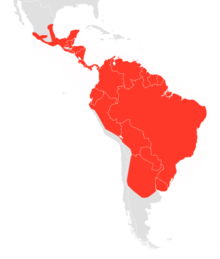Argentine brown broad-winged bat
| Argentine brown broad-winged bat | ||||||||||||
|---|---|---|---|---|---|---|---|---|---|---|---|---|

Eptesicus furinalis |
||||||||||||
| Systematics | ||||||||||||
|
||||||||||||
| Scientific name | ||||||||||||
| Eptesicus furinalis | ||||||||||||
| ( d'Orbigny & Gervais , 1847) |
The Argentine brown broad-winged bat ( Eptesicus furinalis ) is a broad-winged bat that is native to Central and South America. Eptesicus dorianus is treated as a synonym for Eptesicus furinalis , but there is a discussion whether it could be a species of its own.
description
The Argentine brown broad-winged bat is a small to medium-sized bat weighing 7.3 to 8.1 g, with a broad nose and fleshy lips. The head-torso length averages 92.4 mm, with the females mostly being larger than the males (sexual dimorphism ). Eptesicus furinalis differs from other smooth noses in its area of distribution by the large, broad head, the stocky body, the round ears, the short, wide wings and the brownish-black fur. The species also has four upper incisors. It is larger than its sister species E. diminutus and smaller than the Brazilian broad-winged bat ( E. brasiliensis ). The tragus is long and pointed, and reaches halfway up the ear. The ears and the flight membrane are hairless and dark brown to black. The skin begins at the tip of the toes.
Way of life
The Argentine broad-winged bat lives in a wide variety of habitats, including tropical rainforest and dry forest . It is often found in buildings in partition walls, in attics and behind shutters. Of course, the species sleeps between tree bark and in hollow trees and tree holes. Like most bats, it is nocturnal and feeds on insects.
The species is likely to have young all year round, but most of the births appear to take place in the warmer months, probably because there are fewer insect populations in winter. The time of mating and birth differs from population to population due to the wide distribution. The females give birth to one to two young animals per litter.
distribution and habitat
The distribution of the Argentine brown broad-winged bat extends from southern Mexico to Argentina . Thanks to its widespread use, the IUCN classifies its population as stable and safe.
Web links
literature
- R. Mies, A. Kurta, DG King: Eptesicus furinalis , Mammalian Species, No. 526 (2009): pp. 1-7
